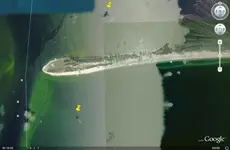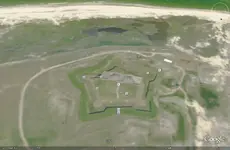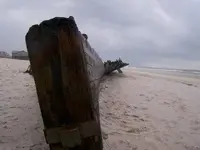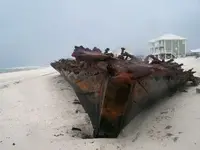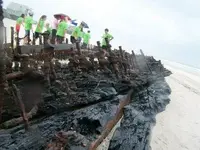Published: Sunday, December 3, 2006 at 4:30 a.m.
It’s always treacherous to venture into the waters around Mobile Point, but in the autumn and winter it’s especially so.
Heavy storms ride on the waves of cold fronts, churning the Gulf and pounding the beaches. The tides and currents are powerful and unpredictable. Many a swimmer has been drowned off this long, narrow sand spit; many a sailing vessel has been wrecked and beached.
But days like this past Thanksgiving disguise the dangers.
The morning broke blue and sunny. A mild land breeze ruffled the wave tops; off Fort Morgan, a pod of dolphins --there were at least 20 or them -- were leisurely fishing.
Seated on their overturned buckets and occasionally casting a wriggling minnow into the bay, was doing the same on the dock, hoping for a run of flounder. Two dirty-brown pelicans, looking as grizzled and bored as their human companions, squatted on the boards, biding their time for a trash-fish handout.
Clutching a newspaper clipping, I walked the shoreline near our rented cottage in search of a mystery ship.
A former colleague, Julia Harwell Segars, sent me the story published in the Mobile Press-Register. High surf in late October uncovered the remains of a big wooden sailing ship on the beach not far from Fort Morgan.
Local historians weren’t sure what it was. The wreck looked old -- it was built with wooden pegs -- but it also had a spine of metal stobs that extended in a twin row about 100 feet in a ragged line down its center. Emerging from the sand, it looked like the rusted bones of a prehistoric mosasaur.
Some speculated that it was a molasses barge that caught fire and ran aground, though not necessarily in that order. Others thought it might have been a rum boat that ferried illicit alcohol to fuel Mobile’s partying spirit.
The most intriguing possibility was that it was a Confederate blockade-runner that had come to ruin trying to make it through The Swash, a narrow channel between the beach and the Union warships that hovered in deeper water near the mouth of Mobile Bay.
That conjecture was fanciful, perhaps, but not totally out of the question. Not far from the mystery ship site, the verified remains of the steamer Ivanhoe, a Civil War blockade-runner, are buried under the sand.
The Ivanhoe got stuck on July 1, 1864. Four days later, Yankee sailors boarded the abandoned steamer and burned it to make sure it would never make the run again.
Another blockade-runner, The Denbigh, navigated by a luckier star.
Built in England, the swift, light-draft side-wheel steamer slipped out of Liverpool in the fall of 1863. Its owners hoped to make their fortunes by smuggling goods into the Confederacy.
Its first run almost ended in disaster, however. Headed out of Mobile Bay for Havana in early 1864 under cover of heavy fog, it ran aground near Fort Morgan. The federal fleet spotted the ship and began firing at The Denbigh; one cannonball tore a hole through the wheelhouse.
Confederate batteries at Fort Morgan responded in kind; the boom of cannons and the acrid odor of gun smoke drifted across Mobile Bay. One of the union vessels took three hits; the rest of the blockading fleet backed off.
The Denbigh’s crew, meanwhile, worked frantically to free their ship. Finally they were able to unload enough cargo to refloat it. It returned to Mobile, scarred but still seaworthy.
In fact, its speed and design proved more than a match for the heavy Union fleet. It made monthly runs to Havana through early spring.
Typically the blockade-runners would ship out with Southern cotton and bring home guns and ammo, sugar, rum, food and even fancy dress goods for the ladies.
The Denbigh was the last ship to wriggle through the federal gauntlet before Admiral David Farragut thundered into Mobile Bay on Aug. 5, 1864, ending the escapades of daring seamen who broke the federal quarantine.
By the time I hit the beach, the notion that the mystery ship was a blockade-runner had gotten a strong grip on my mind.
The photo in the Mobile newspaper was intriguing. It showed a local historian, crouched down on the beach, examining the crusted, thick planks and long spikes extending from them.
The story quoted a resident who said she had lived in the area for 11 years and had never seen the wreck before the late October storms uncovered it.
But on this beautiful November morning, there was nothing to be seen. No trace of the mystery ship.
I tried to match up the spot on the beach where I thought the wreck might be with a house in the newspaper photo.
No dice. There was only pure, white sand. The whole wreck had vanished.
It was frustrating but somehow it seemed fitting as well. Even after shipwreck, fire and more than 140 years on the beach, these blockade runners remained frustratingly elusive.
Ghost ships. I loved the thought of it.
My little sister, who I think had come along mostly to humor me, burst my bubble.
“I’m sorry to bother you," she said to a man who was playing with his child near the edge of the surf, “but we’re looking for an old ship. Have you seen it?"
It takes guts to ask a total stranger a question like that, I thought. But the man surprised us with his reply.
“There was an old wreck, right up there. It was uncovered a couple of days ago but it’s covered back up again."
He gestured to a spot just up the beach from us.
“Come on," he said. “I’ll show you where I think it was."
We walked with him to a spot where he dug a little with his toes. An iron stob emerged.
“That’s it," he said.
And sure enough, that’s where the mystery ship lay buried.
We dug a little bit and more spikes began to pop up. Pretty soon, beachcombers started to drop by.
“What is it?"
“Old ship," I said. “Might be a Civil War ship."
One man shook his head and laughed. “I hope it’s a ship that one of ours sank," he said in a heavy Southern accent.
“No, I think one’s a Confederate ship," I said.
He shrugged, kicked some sand and walked off.
But we kept finding spikes. It wasn’t long before the place was swarming with kids.
Little Burch Franklin, dressed in a sun suit, dug in the sand near the hull with her older brother Hardy as their parents, Webster and Penny Franklin, vacationing from Tunica, Miss., supervised.
A Birmingham resident stopped by. He said he’d seen the wreck in various d stages, depending on the weather, over the past few years.
At one point, he said, the wind and rain had exposed some of the ship’s metal plates. They had been made in Mobile and were stamped with a date of 1930, he said.
I think he noticed my disappointment.
“It could be an older ship that was fitted later with the metal parts," he added consolingly.
He promised to e-mail me some more information but I still haven’t heard from him.
The kids, meanwhile, continued to dig away.
“I think next time we come down here, we’ll rent that house right there," one of their parents said, pointing to a comfortable looking two-story cottage directly in front of the wreck. “We can sit up on the porch and make some drinks and watch the kids dig this thing up all day long."
The children’s imaginations were running wild. So was mine. In a way, I hoped I’d never hear from the guy in Birmingham again.
Digging with abandon, the youngsters had exposed the ship’s pointed prow. The wood, cobbled together with pegs, was planed smooth and slick.
Yep, I was thinking. Slick as the wind. Sure looks like a blockade-runner to me.
A short video of the mystery ship may be accessed at
http://algulfcoastvideo.com/Videos/Shipwreck/woodenship.html
 I will dig the sand with my hands so i will not damage the old wood
I will dig the sand with my hands so i will not damage the old wood 
